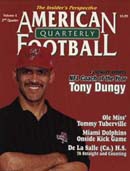AMERICAN FOOTBALL MONTHLY THE #1 RESOURCE FOR FOOTBALL COACHES
Article CategoriesAFM Magazine
|
Extraordinary Success Miami's Onside Kicking Gameby: Mike WesthoffSpecial Teams Coach Miami Dolphins © More from this issue At Miami, we teach and use the onside kick in two specific ways: (1) a "surprise" kick where we attempt to catch our opponents off guard; and (2) the desperation situation-the typical onside kick circumstance where you have to get the ball back. We have been exceptionally efficient in this phase of the game. As a matter of fact, during 1997 in our game versus New England (November 23, 1997), our kick coverage team recovered an NFL record three in the same game. I am convinced our success is due to our planning and the dedicated way we practice it in a full-speed manner during training camp and in-season. The Surprise Onside Kick With the surprise kick, we execute from a regular kickoff formation and, if all goes according to plan, it will be a surprise to the receiving team. We want to tr....The full article can only be seen by subscribers.
|
|
|||||||
| HOME |
MAGAZINE |
SUBSCRIBE | ONLINE COLUMNISTS | COACHING VIDEOS |
Copyright 2025, AmericanFootballMonthly.com
All Rights Reserved





